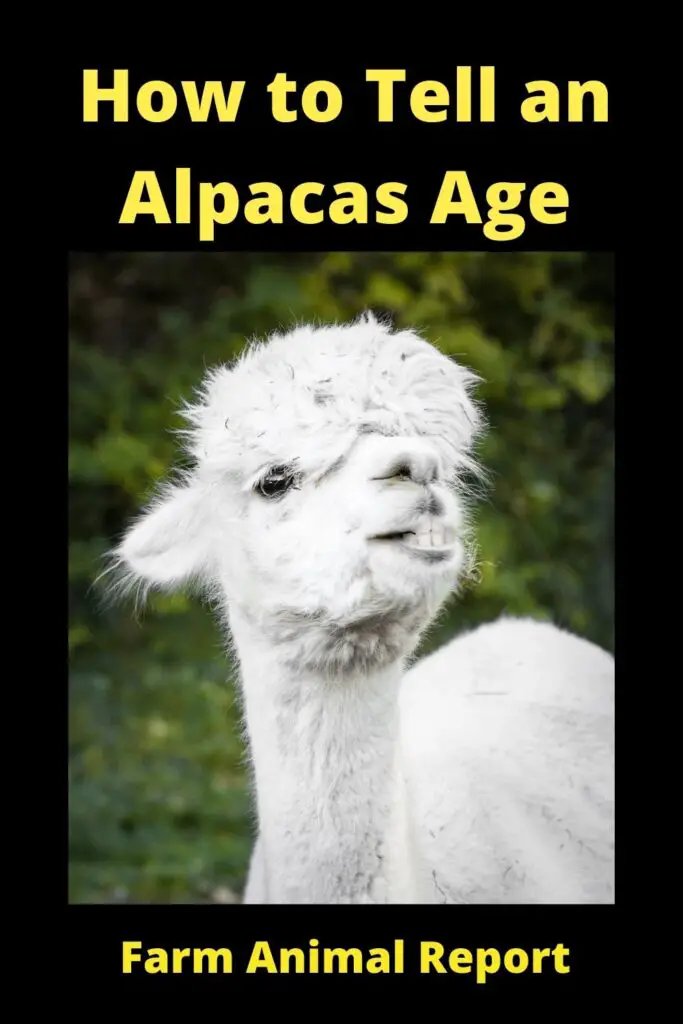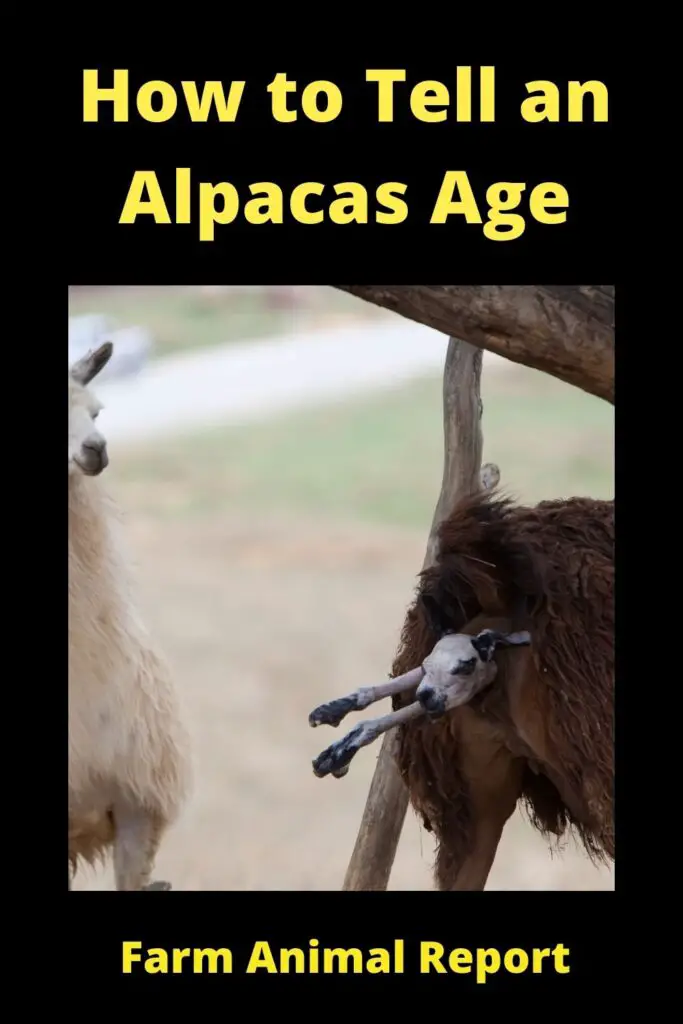How to Tell an Alpacas Age
As a General rule – Alpacas are measured in terms of their age using a system that calculates how many ‘growth rings’ are on the surface of their front incisor teeth. One ring represents one year. The pattern and widths of these rings can be used to determine the Alpaca’s age. Additionally, new research has found that Alpacas can also be given an accurate ‘human’ age on their teeth by researchers at Ohio State University College of Veterinary Medicine and Texas A&M University.
How to Tell an Alpacas Age – The average alpaca lives to be between 15 and 20 years old. The lifespan of an alpaca is based on multiple factors such as genetics, breed, and living conditions. The lifestyle of the owner greatly influences how long an alpaca will live. An alpaca raised in a sunny pasture with plenty of food will likely live longer than an alpaca that lives outside 24/7.
3 Ways on How to Age an Alpaca
There are three different ways to measure an alpacas age: teeth, years of age, and pregnancy. These are all significant factors in determining the age of an alpaca.
- Teeth
- Years of Age
- Pregnancy
Generally, when looking at alpacas teeth, they will miss some due to molting (dropping their baby alpaca teeth). Usually, there is only one year gap between each tooth, so counting them can give you a general estimate of how old your Alpaca is. This only works for lower-end alpacas. More expensive breeds will have a more significant gap between their teeth, and usually, there are no missing molars at all, making it very difficult to determine age by teeth alone.
Years of age can be determined from the spine or camelid standards depending on the breed. This method takes the most effort and is more for alpaca breeders than anyone else.
The last way to tell how old an alpaca is is by pregnancy. This is the easiest way to figure out if your Alpaca is a female and when she may be able to give birth again. Usually, females will stay in good weight and condition until they are done having babies. One warning, though, is if you find an alpaca is pregnant and they are often out with males, the pregnancy may not be accurate. Sometimes, it can also be hard to tell, so consult a veterinarian if you suspect your female is not getting bred.

Once you have determined the age of your alpacas, it is essential to understand their life expectancy and what to expect as they age. A female usually lives about fifteen years, and a male might make it to twenty years of age, with some living until 25. As Alpaca gets older, they start losing teeth and becoming less fertile and unable to breed. If you plan on selling your alpacas, these factors will be considered when you offer them for sale. It is also important to remember that as your Alpaca’s age, they will need more food and attention, which can be both a time-consuming and expensive commitment.
In short, the best way to tell how old an Alpaca is by its teeth. If you have a large number of alpacas, then it may be best to consult a veterinarian. Other than that, be sure you understand what your Alpaca’s age means and how it affects them in the long term.

AU – Wheeler, Jane
PY – 1982/01/01
SP – 12
EP – 17
T1 – Aging llamas and alpacas by their teeth
VL – 1
JO – Llama World
ER –
Why Does it Matter how Old an Alpaca is?
It matters because the longer a female alpaca has been pregnant and given birth without another pregnancy, the more chance of developing uterine cancer. If you are looking to buy an alpaca, you must know when she was last bred.
If you are interested in buying a female, ask the person you are buying her from when she had her most recent cria. You want to make sure she has not had more than one pregnancy within the last three years. If they cannot answer when she was last bred, walk away and find yourself a different alpaca.
If you are looking to buy a male, it is not as important when he was last bred, but if they have been running with females, there may be a chance of him being in a rut, which will make him harder to handle. Some breeders allow their males to run with the females for a designated time. Some people will offer stud service with their males, but this does not mean they are in a rut; it just means they can breed females if the buyer wants them to. ( $500 – $1500 )

At what Age is an Alpaca Fully Grown?
A full-grown alpaca is usually between the ages of 8 and 12 years old. Females are considered to be fully grown at about six years; for males, you can expect them to reach their full size by age 10 or 11.
Alpacas typically become sexually mature around 18 months, but it’s best not to breed your animals until they’re fully grown. This will reduce the risk of injury to one or both alpacas and preserve the mother’s health during the pregnancy and delivery.
What is the Life Expectancy of an Alpaca?
Alpacas live 15-20 years. Some rare cases have recorded them living up to 25 years. Alpacas are considered “in their prime” between the ages of 4 and 8, meaning that they are at their healthiest, strongest, and most productive during these years.
Well-bred alpacas are capable of reproducing by the time they are 18 months old. Females usually have their first cria (baby) between 12 to 14 months. Males can be used for breeding beginning at 18 months of age, but some breeders wait until the males are two years old before breeding because that is when they mature physically and have sufficient size.
What Happens when they Retire from Breeding?
Breeding alpacas can retire at around eight years old and be sold to other farms for alpaca farming or sometimes kept as pets. They typically start to slow down in their breeding by the age of 5.

How much do Alpaca Cost?
Alpacas can range in price from $500-20,000 depending on the quality of the animal and whether it is male or female. Males typically sell for higher prices than females at auctions because there are more potential buyers.
When purchasing an alpaca, there are many factors to consider, so it is essential to have a well-thought plan before making the big purchase.
Initial costs
The first step is determining how much money you can spend on your new addition. Unfortunately, this is usually the most expensive part of owning an alpaca. Alpacas cost anywhere from $500 to upwards of $20,000 per animal. The price can vary depending on several factors:
What will you use your alpacas for?
Are there any unique markings or bloodlines that make one animal more valuable than another?
What are the age, sex, and health of the alpacas?
Where are they located? Are there transportation costs to get them home with you?
What is the Breeding Age for Alpacas?
Managing the Breeding Age Alpacas are bred for alpaca fiber and alpaca wool, not for breeding age. Because of this, there is no set rule on when alpacas mate. The decision can be based on many factors, including fiber production, estrus cycle, cria’s birth date, and gender.
The breeding and sexual behavior, and maturity of the Alpaca are similar to that of llamas. An age of 18 – 24 months is considered an appropriate time for mating with a birth range of April-July.
Male Alpacas are mature sexually around 18 months, sometimes as early as 16 months, but 20 – 24 months is more common. Female adult alpaca are sexually active at approximately 18 months, sometimes as early as 16 months, but 20 – 24 months is more common.
Breeding for most alpaca breeders in South America is done during an eight-week breeding season beginning in late June or July and continuing through September. This period has proven to be an ideal window for mating and achieving conception.
For optimal breeding efficiency, it is common to introduce a single male to more than one female to increase the number of pregnancies per year. While this is not required, it is generally recommended. The introduction of multiple males will reduce breeding efficiency as no male alpaca can cover all the females in one day.
Typically, male alpacas are introduced to female llamas or female alpacas with llamas present for initial interest and acceptance. It has been found that female alpacas (regardless of whether they are in company with llamas) will be more easily approachable by male alpacas if other females are introduced to the male before introducing him to an individual female.

breeding season
18 ways Alpaca Farmers make Money
How to Compare Alpaca Years to Human Years?
Alpacas typically live for around 15 to 20 years, although some have been known to reach the age of 25. In human years, this would be equivalent to around 75 to 100 years. When calculating an alpaca’s age in human years, it is important to take into account their lifespan as well as their growth rate. Alpacas reach full size at around 2 to 3 years old, whereas humans continue to grow until they are around 18 years old. This means that, on average, an alpaca will be the equivalent of around 30 to 40 years old in human years when they reach adulthood. As a result, when comparing alpaca years to human years, it is important to keep these factors in mind.
Final Thoughts
When choosing Alpaca as a pet animal, one of the essential things we need to know is their age or growth period. It’s necessary because we cannot expect what will happen in the future of Alpaca if we do not know their growth period. To ensure the best possible care for your Alpaca, it is essential to determine their age.


